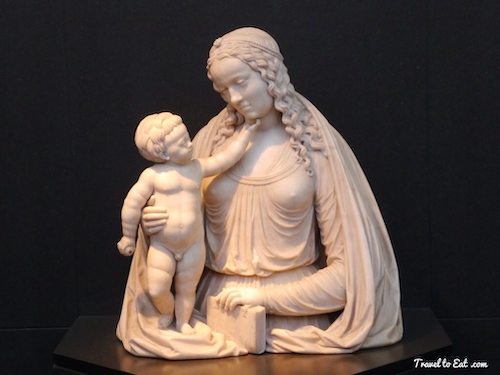
In addition to the beautiful building of the Cathédrale Saints-Michel-et-Gudule in Brussels, they have some lovely art that I thought I would share. For me, the virgin and infant shown above is one of the most delicate and evocative portraits I have seen. I must admit to spending time in front of this sculpture and being moved when I left. I resolved to do some research on Conrad Meit and I found a quite interesting story. As court sculptor to Margaret of Austria in Mechelen beginning in 1514, Conrad Meit (1470-1550) was a major proponent of the Renaissance style, noted for his fusion of German realism and Italian idealism. Also his introduction of the secular bust, which emerged in Northern Europe only around 1500 makes him a seminal figure in the history of sculpture and art collecting in the tradition of the Kunstkammer (cabinet of art and marvels). Both Albrecht Dürer and Lucas Cranach the Elder appreciated the work of Meitner Conrat (Conrad Meit). On his journey to the Netherlands, Dürer (who may have known the sculptor from Wittenberg) dined with Meit several times. In his diary, he referred to Meit as, “The good carver named Conrad, whose equal I've never seen, who serves the Emperor's daughter Margaret”. This is one of his larger sculptures at about 25 inches in height.
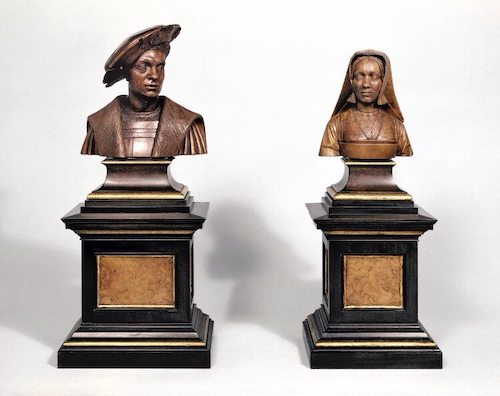
Meit’s most important patron, Archduchess Margaret of Austria, was the daughter of Archduke Maximilian (later Emperor Maximilian I) and Duchess Mary of Burgundy, born in Brussels in 1480. Her third and final marriage to Duke Philibert II of Savoy was arranged by her father in 1501. From 1501 until the Duke’s death in 1504 the couple led a princely life in their residences on the Savoyan territories. Later descriptions of Margaret’s life mentioned this period as the happiest one. Margaret of Austria ruled the Netherlands from 1507 until her nephew Charles came of age in 1515, and again, as the “régente et gouvernante” from 1519 until her death in 1530. She built her residence, the so called “Hof van Savoyen” in Malines, where she also took care of her nephew Charles, the future Emperor, and his sisters. The two busts shown above by Meit from 1515-1525 in the British Museum are about nine inches tall. Philibert wears a close cap of rich network and flat hat with wide brim. Under the brim is circular badge with an inscription and St Margaret piercing the dragon with a cross. He also has a fur mantle over a pleated shirt and plain jerkin. Margaret wears a cap of folded linen, plain chemisette without pleat or collar and necklace of beads with the bodice cut square, plain across the front with loose sleeves.
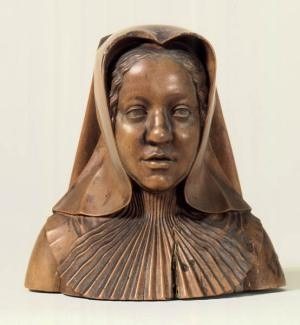
As court sculptor to Margaret of Austria in Mechelen beginning in 1514, Conrad Meit worked in Mechelen (Malines) in Flanders; he created small objects for Margaret's Kunstkammer, or collector's cabinet, working with equal skill in boxwood, alabaster, and bronze. His specialty was the small portrait bust, a curious specialty, most of his busts are less than a foot tall, obviously meant to be placed in a cabinet and perhaps held lovingly in the hand. Although non-religious busts were common in Roman times, they did not reappear in Northern Europe until about 1500. Margaret must have been very fond of her late husband, she commissioned several portraits of him and of herself. The small 3 inch tall bust shown above from 1518 shows her in her role as governor of the Netherlands.
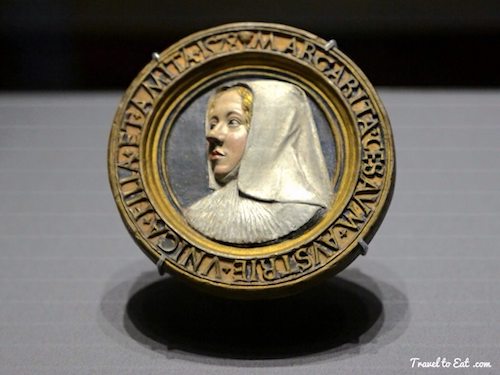
Archduchess of Margaret of Austria (1480-1530) was regent of the Netherlands and the first important Habsberg collector. This painted clay medallion is based on an authorized portrait of the art-loving princess of which numerous copies are known. The inscription emphasizes her august rank as the daughter of emperor Maximilian I and aunt of emperor Charles V.
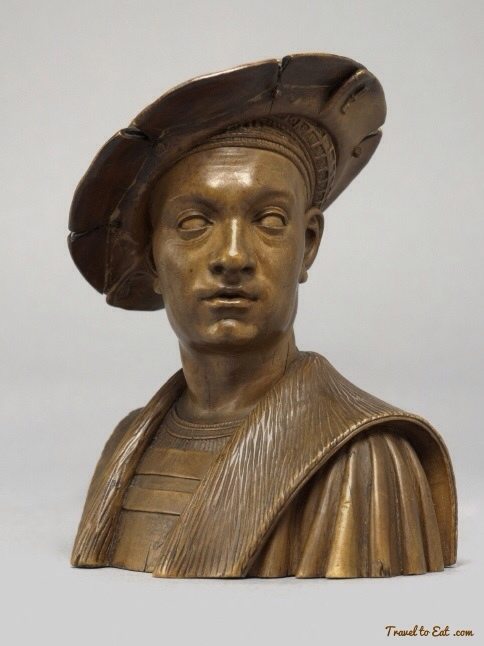
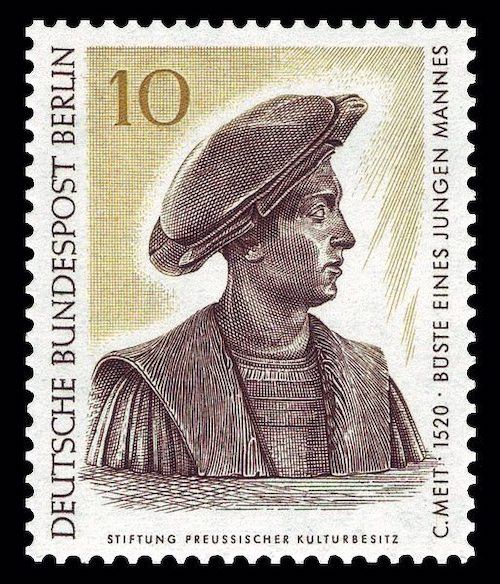
This small bust (11.6 cm or 4.5 inches tall) shows the Duke Philibert II of Savoy (1480-1504). The Duke is shown without insignia. But the elegant costumes and the spontaneity of the turned head to shoulder with the wide-brimmed, diagonally mounted backwards beret are evidence of a confident personality. The young man's face is extremely lifelike so that the bust despite its miniature dimension has a remarkable monumentality and presence. Margaret's court sculptor Conrad Meit (Conrat Meitner), who stood since about 1514 in Mechelen in their service, performed this lifelike portrait of the Duke after his death. He would have had to rely on older images and descriptions of his wife. Due to the prominent role of Philibert’s various portraits, the library appears not only as a memorial to Margaret’s late husband, but also as a statement of Margaret as the Dowager Duchess of Savoy. The pious widow’s personal feelings cannot be the only justification for the variety of representations of Philibert in the library; while commemorating her husband, the Dowager Duchess of Savoy was proclaiming her legal rights to the Savoyan territories that she had been given as source of income.
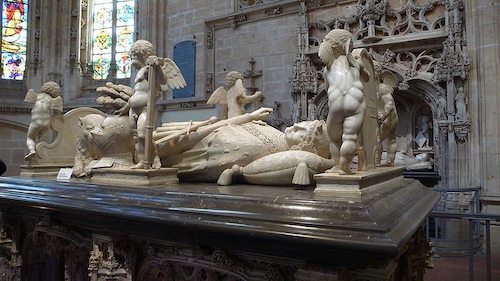
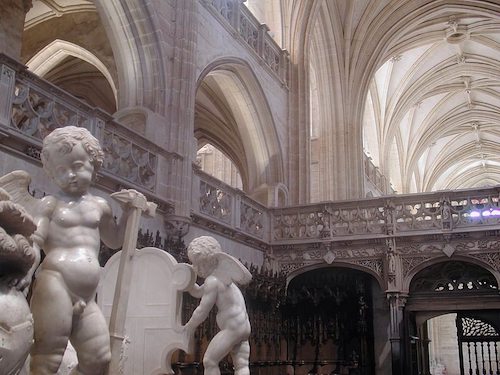
In 1526 Meit undertook his first monumental project: the tombs of Margaret, Philibert, and Philibert's mother, Margaret of Burgundy. Meit was commissioned to carve the faces and hands of all of the tombs' figures, while assistants helped with the rest of the project. Upon the successful completion of this work, he received commissions for other large-scale tomb projects and statues. This is the tomb of Philibert II of Savoie in The Église de Brou (Bourg-en-Bresse, Ain, France) from about 1530. Note the similarities of the cherubs to the infant from Cathédrale Saints-Michel-et-Gudule.
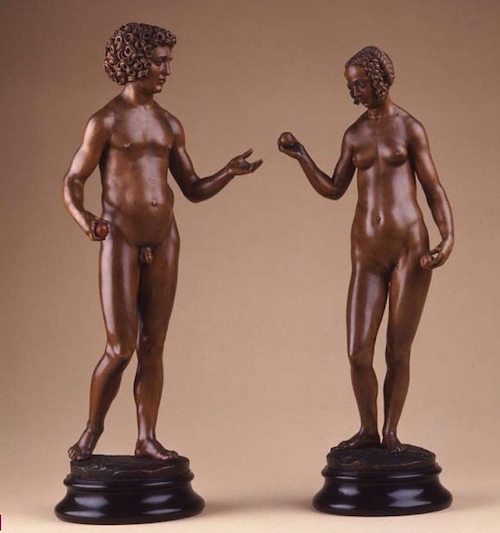
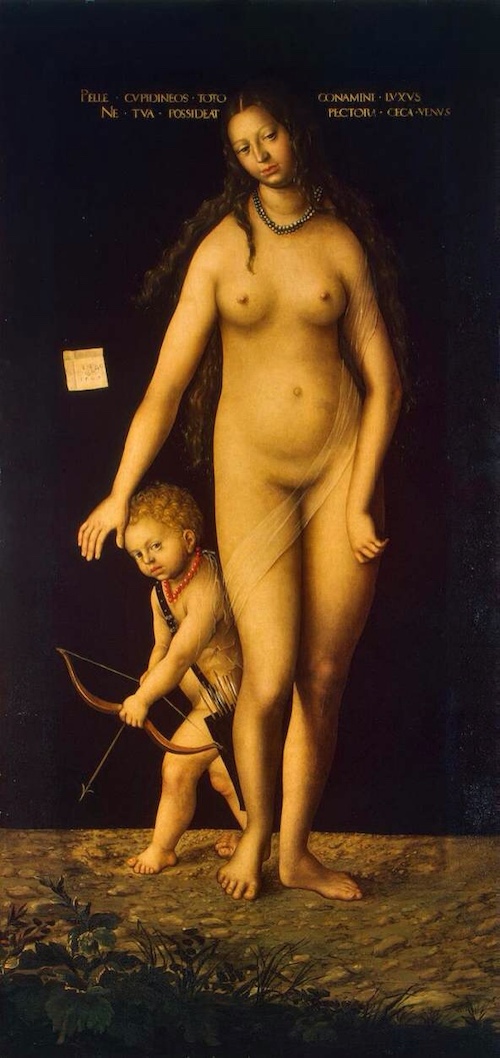
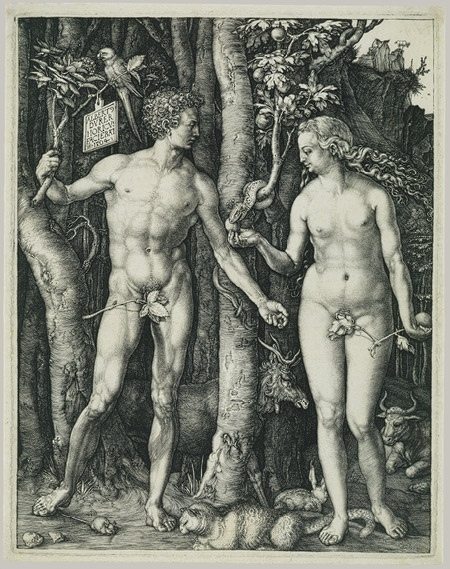
This set of sculptures, his Adam and Eve statuettes at Schloss Friedenstein, Gotha, were acquired in Nuremberg as works by Albrecht Durer in 1817 and then re-attributed to Meit. This pair of figures is one of the earliest and most impressive examples of small figurative Adam and Eve depictions of the Renaissance in the North. Pre-eminent in the accurate observation of the body, Meit's pair of figures is a specific form of North-European nude sculpture in the Renaissance. The inspiration for the nude figuration of his Eve with her fluent shape is probably the Venus of Lucas Cranach the Elder (Venus und Armor) of 1509. The rear view of the Gotha Eve is directly related to Albrecht Dürer's nude drawing of a female back view from 1506. Dürer's etching of Adam and Eve in 1504 gave the first impulse for dealing with nudes at that time and can be named as the prototype for Meit's Adam. The dating of the pair of figures around 1510 is supported by other similarities with works by Cranach and Dürer that were made before 1510. However, Meit's figures are not just compositions of single elements from Dürer's and Cranach's works. What they show is that on the one hand Meit is geared to the style of Cranach's early nude depiction, but on the other hand is not just interested in the decorative beauty of that nudes. He followed his keen interest in the exploration of the body and its proportions. Hence he focused on the accurate rendition of the body and its details , for instance the accurately worked out genitals. Above them both figures show a vaulted stomach. In addition to that the joints of the limbs to the torso show the functional aspect of the moving body being worked out in details such as skin folds in the crook of the arm and the tensed or relaxed muscles and sinews.
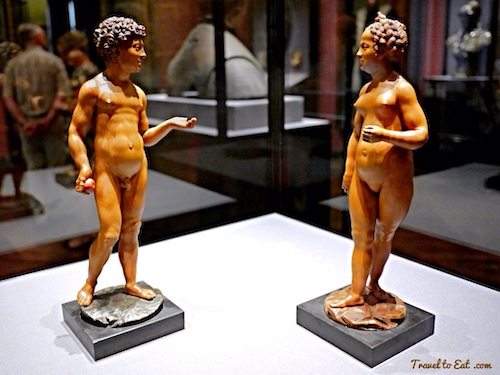
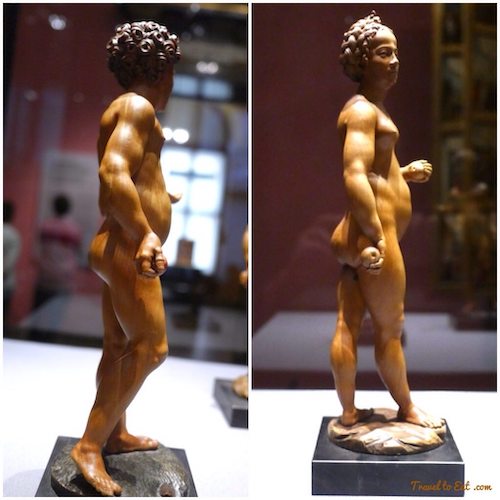
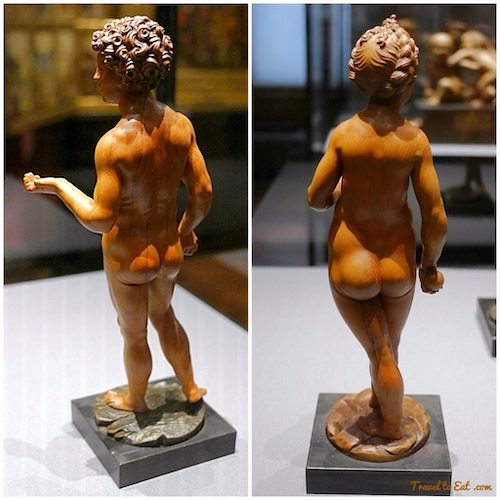
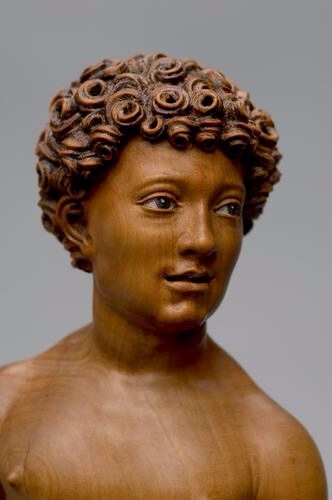
In 1520 Meit returned to the theme with an entirely different approach. In this set of figurines made of boxwood from the Kunstkammer Wein we see an evolution of his conception of the human body from the idealized elongated figures of 1510 to these much more realistic bodies, shorter, more realistic bellies and Eve's wider hips. Also the the two bodies are posed toward one another in an elegant twisting movement and Eves legs and feet are in a remarkably complicated position. Both figures are posed in a very renaissance contrapposto style. Contrapposto is an Italian term that means counterpose. It is used in the visual arts to describe a human figure standing with most of its weight on one foot so that its shoulders and arms twist off-axis from the hips and legs. This gives the figure a more dynamic, or alternatively relaxed appearance. It can also be used to refer to multiple figures which are in counter-pose (or opposite pose) to one another. Classical contrapposto was revived in the Renaissance by the Italian artists Donatello and Leonardo da Vinci, followed by Michelangelo, Raphael and other artists of the High Renaissance. One of the major achievements of the Italian Renaissance was the re-discovery of contrapposto. Here we see the development of Meit as an artist and the influence of the Italian Rennaisance on his work. I would also point out Eve's hair, particularly in the back, an area of expertise for Meit. Finally both the apple and eyes of Adam are colored, Eve's are not, I wonder if Eve is unfinished or the coloring just wore off.
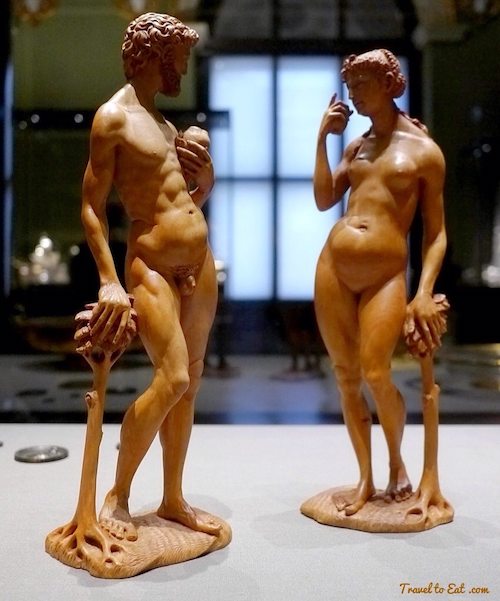
In just the next cabinet they have this lovely unattributed Adam and Eve (31.2 cm tall) that I thought I would include for comparison. These also have nice hair and the contrapposto has been exaggerated into a serpentine “S” curve or “Line of Beauty”. According to this theory, S-shaped curved lines signify liveliness and activity and excite the attention of the viewer. This theory originated with William Hogarth and is an essential part of Hogarth's theory of aesthetics as described in his Analysis of Beauty from 1753.
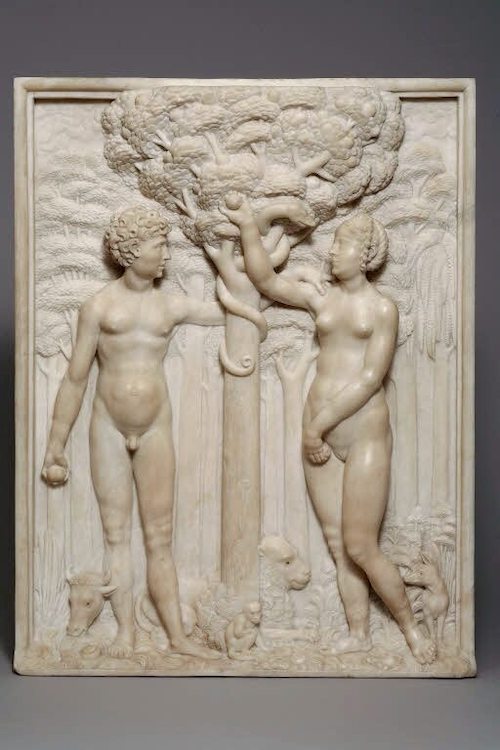
This small 19 inch tall marble bas relief from the Louvre has been attributed to Meit or one of his followers due the similarity in the depiction of Adam and Eve and to the small size. It can be found in the Denon wing, Salle C.
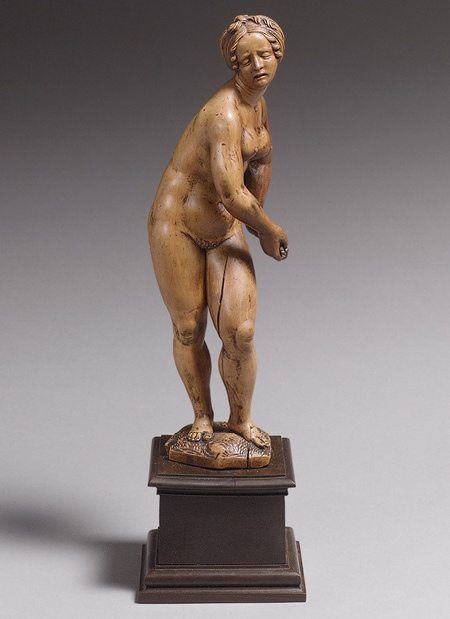
Lucretia, a beautiful and virtuous noblewoman of ancient Rome, committed suicide after being raped by the king's son, which set off the rebellion that established the Roman Republic. Her legend also inspired paintings by Meit's contemporaries Albrecht Dürer and Lucas Cranach. This eight inch tall sculpture from the Metropolitan Museum of Art was very influential among his contemporaries including Jan Gossaert (Mabuse). Meit created the first sculpted secular nudes and sculpted portrait busts north of the Alps. His carving is dazzling, and the figures exhibit a balance between form and detail that shows no trace of the gothicism that continued to dominate northern sculpture for decades to come. Meit gives us specific musculature beneath a smooth layer of flesh but also shows the pressure of a weight-bearing leg on the arch of the foot. Details include articulated toes and even toenails on feet about an inch in length.

You can see the influence Meit's Lucretia had on Jan Gossaert (or as the name he adapted from his birthplace Jan Mabuse). Owing in part to their appointments in two humanist courts, those of Philip of Burgundy and Margaret of Austria, Gossaert and Meit shared a common interest in mythological themes. Through his acquaintance with Meit, Gossaert came to share the German's sculptural approach toward these themes. It cannot be a coincidence that the figure, and especially the twist of the body, of Venus in Gossaert's 1521 “Venus and Cupid” appears so similar to Meit's boxwood Lucretia.
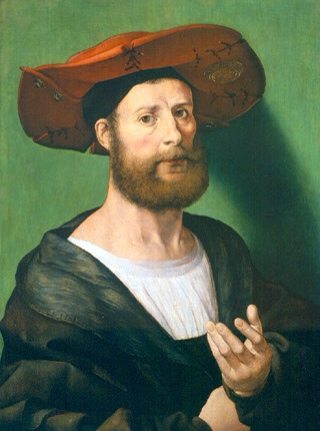
In a comparison with the greatest painter of antiquity, Jan Gossart or Mabuse (1478–1532) was repeatedly acknowledged as “nostrae aetatis Apellem” (the Apelles of our age). This praise first appeared in two separate texts of 1516 and 1529 by Philip of Burgundy's court poet and humanist, Gerard Geldenhouwer. Lodovico Guicciardini (1567), Giorgio Vasari (1568), and Karel van Mander (1604) all described the themes of Gossaert's art and credited him with being the first to bring from Italy to the North the art of depicting historie and poesie with nude figures. Though little remains of comments by contemporary artists concerning Gossaert's reputation, he is said to have earned the praise of German master Albrecht Dürer (1471–1528), who saw Gossaert's Middelburg Altarpiece (now lost) during his trip to the Netherlands in 1520. Jan Gossaert was a pivotal figure between thelate medieval tradition of Jan van Eyck and the Baroque art of Peter Paul Rubens. In 1508 he became one of the first artists to travel to Rome to study painting and the antiques. Upon his return the following year, he introduced the Italian Renaissance to the Netherlands. Unlike the Antwerp mannerists, he went beyond adopting its ornamental motifs and actually understood the Renaissance “spirit”. He must also have spent time in Mechelen, where he was summoned in 1523 by Margaret of Austria to restore certain pictures in her collection and carry out other unspecified tasks. When Gossaert went to Mechelen on that occasion, he stayed with Conrad Meit.
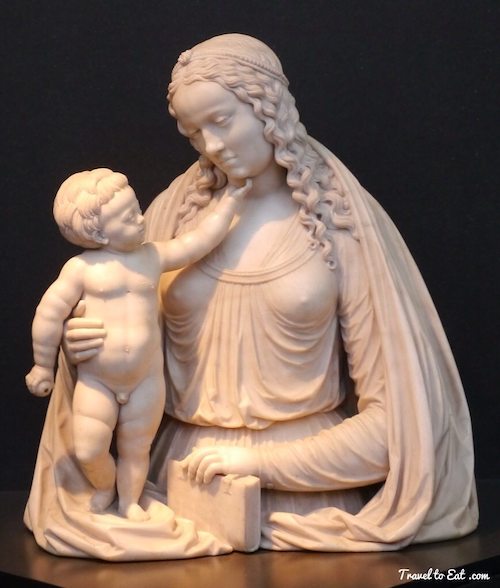
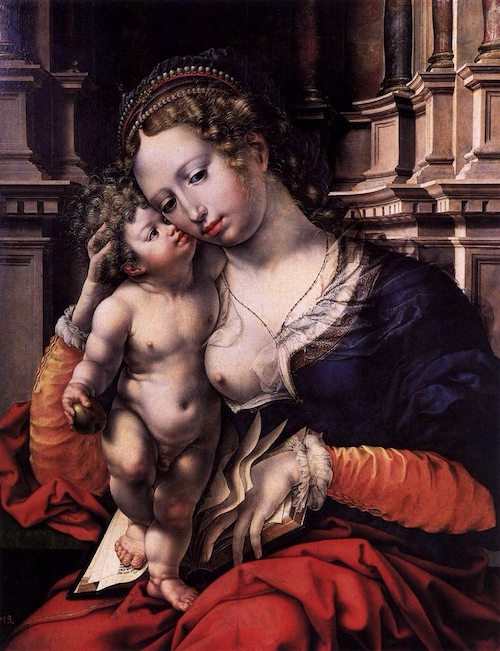
Meit and Gossaert were both intrigued by the textures of fabric, the heightened three-dimensionality of features such as braided or thick, curled locks of hair or draperies, and the smooth porcelain-like finish to flesh, especially that of the face. Look at the similarities between Meit's “Virgin and Infant” to Gossaert's “Virgin and Child”. The apple in the child's hand, the pose of the child, the book and the hair and cap of the mother. When viewed side by side, Meit's sculptures and Gossart's paintings express the same aesthetic goal: a heightened sense of the three-dimensionality of the figure conceived in the round.

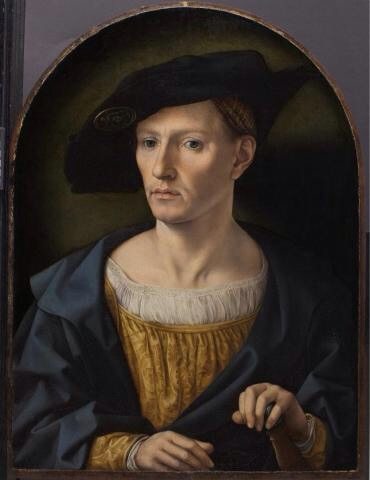
Just one more comparison between Meit's depiction of the young Duke Philibert II of Savoy and Gossaert's painting “Head of a Man”. On the basis of the coat of arms on the right, the figure was for a long time believed to be Frank van Borselen, the fourth husband of Jacqueline of Bavaria. However, this identification is incorrect, because the coat of arms was a later addition to the painting. In fact it was only attributed to Jan Gossaert in 2011 after cleaning as part of an exhibition at the Metropolitan Museum. I wonder, because of the hat and the three quarters pose, if this might not have been commissioned by Margaret of Austria as a portrait of her deceased husband Duke Philibert II of Savoy as a younger man. This thesis gains more credence since there are so few remaining documents of specific commissions for Jan Gossart that can be linked to extant paintings. Most of Gossaert's paintings are single panels, and nearly half are portraits, a genre in which he particularly excelled. It is clear that he was sought after for his extraordinary abilities to represent the lifelike appearance of individuals. Curiously, among the portraits that have survived, only a few depict women, the overwhelming number representing men of the courtly realm and upper levels of society. All of these factors would fit with a commission by Margaret of her late husband.
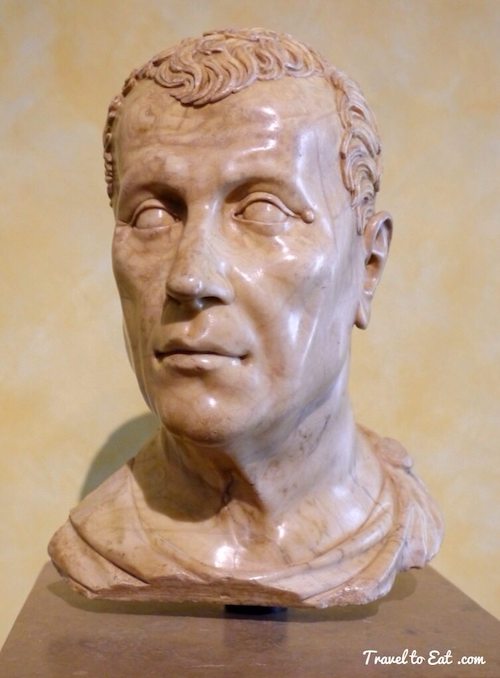
Conrat(d) Meit might have carved the “Head of a Man” about 1515 in emulation of busts from the Roman Republican period; this period favored a stark style with unmarked eyeballs and forward-combed hair. The starfish pattern on the back of the head is also typical of ancient busts. This kind of bust, which has been reset on a modern support, would have probably decorated the interior of a noble residence. The distinctive mole at the corner of the left eye suggests that the subject is Cicero, the famous Roman orator, statesman, lawyer, and poet. According to the Roman historian Plutarch, Cicero's name derived from a description of the mole in Latin as cicer, or chickpea, a feature of the subject which became standard in Renaissance depictions. Constance Lowenthal suggests these words of caution on the attribution to Meit, “We know no instance of Meit directly imitating antiquity, and to make a connoisseur's leap when a sculptor suppresses his own style to copy a work from another period seems risky.”
There are a few other works I could present but this is getting long and I have covered mostly what I wanted. Conrad Meit is a great sculptor although he is relatively unknown because few of his pieces are signed or titled. If you get to Brussels be sure to visit Cathédrale Saints-Michel-et-Gudule and pay the euro to visit the art collection in the back. Meit's “Verge et Infant” is in the back of the area. I think this sculpture is in the general sphere of The Pièta and is a must see.
References:
Kunstkammer: http://www.metmuseum.org/toah/hd/kuns/hd_kuns.htm
Saint-Amand-les-Eaux, Musée municipal: http://www.musenor.com/Les-Musees/Saint-Amand-les-Eaux-Musee-municipal
Conrad Meit by Jens Ludwig Burk: http://www.monuments-nationaux.fr/fichier/editions_ebook_chapitre/711/Brou_10_Burk.pdf
The good carver Meit: http://www.thefreelibrary.com/'The+good+carver+named+Conrad'%3A+Conrat+Meit+in+Munich%3A+Constance…-a0160712019
Man, Myth, and Sensual Pleasures: Jan Gossart's Renaissance edited by Maryan Wynn Ainsworth
Jan Gossaert: http://www.metmuseum.org/toah/hd/goss/hd_goss.htm
Meit, Adam and Eve: http://www.bonhams.com/auctions/14961/lot/320/
Cathédrale Saints-Michel-et-Gudule: /cathedrale-saints-michel-et-gudule-brussels/

